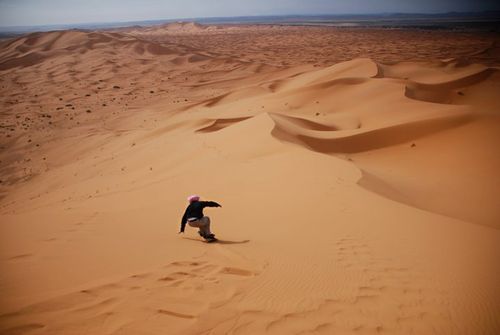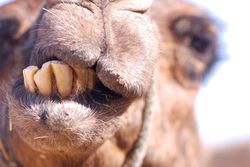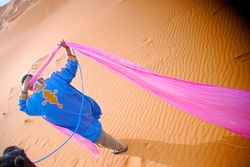
All of it, except our snowboards.
Snowboarding in the western Sahara is likely not the first activity you’re considering if traveling in northwestern Africa. But it should be. Aside from the novelty, the lack of tourists, and the obvious adrenaline factor, it’s by far your best bet for getting to know the desert. That, and I'm a firm believer that no matter where you are on the planet, life's more fun when you're haulin' ass.

Forget lifts or helicopters. To navigate terrain that dissolves and rebuilds around you as quickly as you set your feet down requires the assistance of more specialized transportation. Transportation like burly, fan-footed Arabian dromedaries.
Mine, for instance is named Bob Marley. He's a crotchety camel who gurgles like a drainpipe. We reach a point in the climb too steep for him to continue and tie him to Jimi Hendrix, his hirstute colleague. This keeps them both from bolting as we finish our long climb to the top.
A couple of misconceptions about the desert: for starters, most folks believe it's hot. In reality, Saharan temperatures often dip below freezing, especially in winter.�� Second, people generally envision a low plateau dotted sporadically with cactus or the occasional mummy.�� Also false. Here in the Sahara, there's�� enough extreme altitude gain and loss to satisfy even the biggest gradient junkies. And I've yet to see a single bandaged ruler, or anyone else for that matter. The Moroccan Sahara is spectacularly remote; a solid 12 hours from the nearest major city and thus one of the best kept secrets on the planet.��
From the highest dune (150 m tall) it's possible to see where the 22km of Erg Chebbi spills into the foot of the fossil-rich mountains of Algeria. ��But despite these borders, the dunes feel martian and endless. And after navigating the cramped alleys and chaotic souqs (markets) of Marrakech, they're a welcome relief. 
At the top, the peak is razorblade fine. Little particles of sand dissolve with the wind. We give each other the thumbs up, followed by that little side hip thrust that usually launches every big ride.
And we go nowhere.
Another hip push— nothing. Sand lacks the slippery generosity of snow. A horrible scraping emits beneath my board as I inch down the face of the dune. For a few seconds it looks like the joke is on us.
��But in a moment, gravity steps in. Suddenly, we’re gaining speed, dodging desert succulents and carving over the needlepoint tracks of birds. It's a rougher ride than snow, but its also the best naturally groomed mountain you could hope for. Soon the dunes are a blur and I'm lost in the ride—all bent knees and balancing arms. In seconds, we're covering ground it took us hours to climb. The�� zen moment arrives–that feeling all skiiers and snowboarders experience communing with the mountain. The sun is rising and the wind is rushing in my ears.�� I can see Bob Marley in the distance craning his long brown neck to watch the crazy humans fly.��
�� 
From the main Moroccan airport and train hub of Marrakech, rent your own car and take your time making your way to Merzouga. Or, for those on a tighter budget opt for the 12 hour/$25 (suprisingly comfortable) Supratour bus from Marrakech to Merzouga that leaves daily from the train station.
Equipment:
Ski and Snowboard rentals can be arranged in Merzouga for around $6 dollars a day. There are also several Berber camps in the desert where a limited number of rentals are often available. At night,��the desert drops to 2 °C and lower so remember your sleeping bag, gloves, hat, and lots of base layers if you intend to stay awhile. A note of caution: sand falls are a lot harder than you might think. Wrist guards recommended!
Lodging:
There are a number of Berber auberges along the perimeter of Erg Chebbi where guided camel treks can be arranged. Typical cost for a guided dromedary hire/tent overnight is $40.00/day.
–Shauna Sweeney lives in a frosty corner of the world called Newcastle Upon Tyne. When she's not circumnavigating the globe or napping in airports, she spends her time fighting the good fight as founding editor of the new environmental online magazine, . ��
Photos Courtesy of S. Sweeney